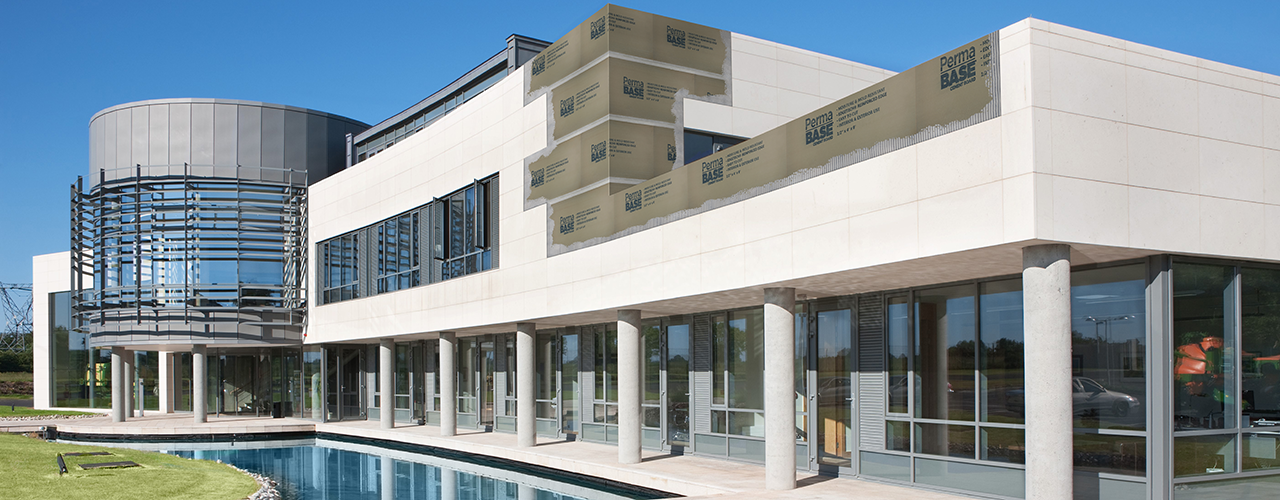 Time-Saving Solutions
Time-Saving Solutions
Exterior installation benefits of PermaBASE Cement Board
Find out how the use of PermaBASE Cement Board can save your next project time and money when installing exterior wall systems

Buildings are only as strong as the materials used to construct them. When it comes to cement boards, National Gypsum Company believes there is no better product than PermaBASE® Cement Board manufactured by our affiliate company, PermaBASE Building Products, LLC.
We decided to put it to the test in a time/cost study conducted by the National Association of Homebuilders (NAHB) independent subsidiary, Home Innovation Research Labs™, an authority on home building product research, innovation and testing.
In the study, Home Innovation Research Labs tasked two crews to finish identical sides of a house — one with metal lath and one with standard 4x8-foot PermaBASE Cement Boards — side by side to determine the effectiveness of each solution. The study revealed using PermaBASE Cement Board as a substrate in exterior wall systems with modified veneer mortar reduces installation time of adhered stone veneer by 35% and total installed cost by 6%.
What are PermaBASE Cement Board and metal lath?

PermaBASE Cement Boards provide durable exterior sheathing designed to withstand prolonged exposure to moisture. Made with Portland cement, aggregate and fiberglass mesh, these boards are lightweight and easy to install. Plus, they feature EdgeTech® reinforced edges that allow nails and screws to be applied closer to the board edge without breaking or crumbling.
With PermaBASE, the crew simply installs a weather barrier and screws the board to the wall — no mixing cement or applying multiple layers of product. PermaBASE was originally used for interior applications (primarily shower and tub installation due to its moisture resistance) but was quickly adapted for exterior use as well.
Metal lath is expanded metal that has a grid-like appearance and comes in sheets. When using it in a project, the installer fastens it to a wall before applying mortar. Metal lath gives the cement scratch coat structure, allowing it to remain in place.
How does PermaBASE Cement Board installation compare to metal lath?
To install metal lath using traditional methods, the crew needs to first install two weather barriers to prevent moisture from the cement from penetrating the outside barrier. Then they must install the metal lath, followed by two coats of Portland cement, the base coat and scratch coat. That adds up to four trips around the building — one for every layer — with time in between to allow the first layer of cement to set. This process alone can take one to two days.
PermaBASE Cement Board is installed in just two steps:
- Install one weather barrier.
- Hang the PermaBASE Cement Board panels.
What happened when Home Innovation Research Labs put PermaBASE to the test?
To test our theory that installing PermaBASE saves time and money over traditional metal lath and scratch, we hired a third party, Home Innovation Research Labs, to compare the installation methods.
The video recording during the test shows crews installing metal lath and scratch coat finishing and PermaBASE Cement Board side by side in a time-lapse format. The video shows the work hours it would take to accomplish each application.
Watch the video to see how much faster using PermaBASE Cement Board makes exterior veneer projects. The crew saved 9.2 hours by installing PermaBASE over the traditional method, making it 35% faster to install than metal lath and scratch.

PermaBASE Cement Board saves installation and cleanup time.

From reducing installation time to keeping a cleaner jobsite, PermaBASE Cement Board brings many benefits to commercial exterior veneer installation.
- Labor savings – Most jobs that take a week to complete with metal lath can be accomplished in just four days with PermaBASE boards, allowing you to complete more jobs per year.
- Less cleanup – No need to mix cement or trim metal lath on-site. PermaBASE is shipped on a pallet, arriving in one clean stack of boards.
- Cleaner worksite – With no on-site mixing, you don’t need to worry about runoff, which can help you stay in compliance with environmental regulations governing worksites.
- Fewer callbacks – PermaBASE reduces callbacks and repairs with its simple installation.
- Lower risk of future issues – With metal lath installation, there are more opportunities for installation error that can potentially lead to failure down the line — PermaBASE makes it easy for crews to install with confidence.
How can you use PermaBASE Board?
With a growing preference for mixed materials on commercial projects, PermaBASE is a simple solution for any of these adhered veneers:

- Natural stone
- Thin brick
- Stone veneer
- Ceramic tile
- Direct-apply or synthetic stucco
The only finishes that aren’t compatible with PermaBASE Cement Board are vinyl and fiber cement siding because these claddings cannot be nailed to cement boards.
In addition to the standard 4x8-foot PermaBASE Cement Boards, they also come in smaller sizes for interiors. The larger size is intended for commercial exteriors and interiors.
Visit the PermaBASE website to learn more about using it and save time and money on your next project.
Be the first to hear of new NGConnects blog posts by subscribing here for early access.







